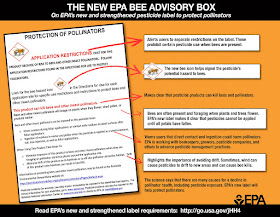Don't Bug Out! Educate Yourself!
Posted by: Sherie Caffey, Horticulture Coordinator, CSU Extension-Pueblo County
I’m sure at some time in
most of our lives, we have reached for a pesticide to help us out with a yard
or garden pest. Being a new homeowner, I found that I had a lot to learn about
the proper use of pesticides. Here’s some of the most important things I have
discovered:
 |
| The new EPA advisory box |
Most people think of pesticides to be
insecticides, but the actual definition of a pesticide is any chemical that
controls a pest, whether it is an insect, a weed, a fungus, a rodent, or any
other thing that is “pest”ering you.
There are many categories
that pesticides fall into. One of the broadest is natural or synthetic. Natural
pesticides are derived from biological ingredients, and synthetics are man made.
If keeping your garden organic is important to you, look for an OMRI (Organic
Materials Review Institute) label on the product you are using, this means it
is certified to be used in organic production. Even though a product may be
natural or organic, it may still be harmful to humans and beneficial critters
in high concentrations, which brings me to the most important point about using
pesticides, ALWAYS read the label! We will come back to this…
 |
| Too late for pre-emergents on this guy |
There are a couple of
other categories that pesticides are separated into. For herbicides in
particular, they may be pre-emergent, meaning they can only control weeds
before they germinate, or post-emergent, meaning you use them after the weeds
have sprouted. Broad spectrum products are not picky, they kill everything,
whereas selective products are meant to control one certain pest. Some
pesticides are soil applied, and others need to be applied to the actual plant.
Finally, protective pesticides prevent the pest of interest, and eradicants get
rid of pests that are already present.
 |
| Signal words |
The most important
information that you can get about safely and properly using a pesticide is on
the label. It is against the law to use any pesticide in a manner inconsistent
with its labeling. There are many things that you will generally find on the
product label. First of all, there will be the product name. There is usually a
brand name (e.g. Roundup), and a common name (e.g. Glyphosate).
 The next thing you should
look for is the signal word, which tells you how hazardous the product is.
These are the signal words you will see, in order from least toxic to most:
Caution, Warning, and Danger/Poison. 1 to 3 drops of a product labeled
Danger/Poison can kill an adult. You should also pay attention to any hazard or
precautionary statements. These statements are meant to protect the applicator
and the environment.
The next thing you should
look for is the signal word, which tells you how hazardous the product is.
These are the signal words you will see, in order from least toxic to most:
Caution, Warning, and Danger/Poison. 1 to 3 drops of a product labeled
Danger/Poison can kill an adult. You should also pay attention to any hazard or
precautionary statements. These statements are meant to protect the applicator
and the environment.
Last but not least, you
will see the directions for use. You must use the product as directed on the
label. The directions will tell you which plants it can be used on, which pests
it is for, application rates, re-application times, and how long to wait until
you harvest if you are using it in a vegetable garden.
So next time you reach
for a pesticide to control a pesky garden problem, educate yourself before you
use it, and remember, the label is the law!

Thank you for educating us on the topic. Surely ignorance is not always bliss. Great post friend. Keep up the good work. Looking forward to more.
ReplyDeleteI've had excellent success in the garden with Neem oil and diatomaceous earth, depending on the pest. Takes more work than commercial insecticides, but is worth it.
ReplyDeletePesticides are not only harmful for the pest but it cause serious threat for the humans and other animals. It is necessary to find out the exact method to use pesticidies.
ReplyDeleteI like reading all the different viewpoints one thing everyone. Please Visit:
ReplyDeletebarn conversion essex
listed buildings london
interior design essex